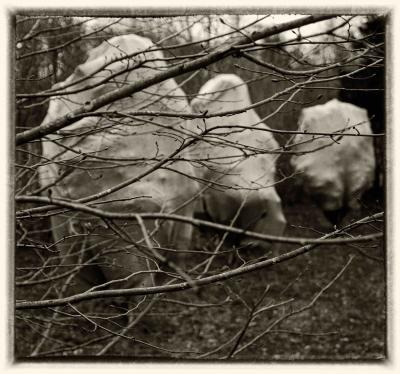Under Wraps: Kathryn Szoka's Haunting Images of Nature

You begin to see them everywhere this time of year, trees and shrubs bundled in burlap as if they are presents. During the holiday season, they almost look normal, as if nature was saving its gifts for a later time. “Don’t open me until March 31,” the wrappings seem to admonish.
By Martin Luther King Day, when all of the trappings of Christmas are finally tucked away, they begin to look absurd and sometimes disturbing (depending on your mood).
Kathryn Szoka has noticed this phenomenon as well, but she has brought even more meaning and weight to the effort of apprehending it. In both words and images, she has shown through her series “Witness” that this simple protective effort for our landscaping has a greater meaning that can be applied to the immediate community and even world events.
To her mind, these burlap wrappings signify “the loss of our agrarian heritage to Mac Burbias and the excessive wealth consuming our community.” In their earlier years of adoption, she also sensed a visual kinship to the hooded victims of Abu Ghraib.
Noting that the wraps seemed overly precious, she also found in them a reflection of an increasingly narcissistic society, “wrapped up in themselves and isolated from others by virtue of our individual technologies and segregated communities.”
In her “Vanishing Landscapes” series, Ms. Szoka has shown a highly developed sensitivity to the environment. In “Witness,” she has also chosen her subjects carefully to bring their more universal qualities to the surface. She uses titles allusively to nudge the viewer into her way of seeing things.
In “Hooded,” the narrow pointy tops of the covered trees do resemble the hoods of the abused prisoners in Iraq, although the more rounded middles make them look rather stout. They reminded me of shields or ancient urns.
“Procession” looks like a line of demure debutantes or a row of cloaked and armless Classical Greek goddess statuary. It is uncanny how little the long line of wrapped objects looks like trees.
“Refugees” is more random in its composition. The shrubs are short, tall, narrow, and blocky. They look like magnified seedlings or sprouts. Their grouping lacks any of the order of some of the others in the series, and the print does have the sense of chaos of a boat landing in Greece.
“I Can’t Breathe” looks like a person, maybe one of Eric Fischl’s “Falling” figurative sculptures inspired by the events of Sept. 11, 2001. There’s even a shoe, although the figure looks to be seated on a trunk that has fallen over. It’s a little jokey for the series and seems staged, which strikes a hollow note among the much stronger work.
“Ghosts,” a procession of objects wrapped in plastic, looks both real and staged at the same time. Either way, it is spooky in spirit. It was here that I was reminded of the dust covers placed over furniture in old abandoned houses in gothic novels or scary movies. That same sense of excess (clearly servants put the sheets on before everyone went back to town or wherever they lived when not at that residence) seems essential to these works’ meaning
There are also wrapped trees dusted in snow, which gives them the appearance of having dandruff. This makes them seem even more human in form. One photo, titled “Secrets,” shows the wrapped landscaping viewed through unwrapped tree branches. The contrast of the branches, clearly hardy enough to withstand the extremes of winter, again points to the inherent absurdities of the practice. It is as if the branches are wryly commenting on the covered plants before them, “Get a load of this!”
All of the photos in this series are shot in black and white, and the tonality seizes on the folds and gathers of the material, revealing both a roughness and grace that would have been lost in color. Ms. Szoka shows a great command of the medium while never becoming too slick or polished. The artistry is balanced but raw. She has burnished the edges of the prints, as well, to carry over the rough qualities of the burlap.
With the photographs are a few paintings by Dennis Snyder, also of East End landscapes. They will remain on view with the photographs through Dec. 31.
